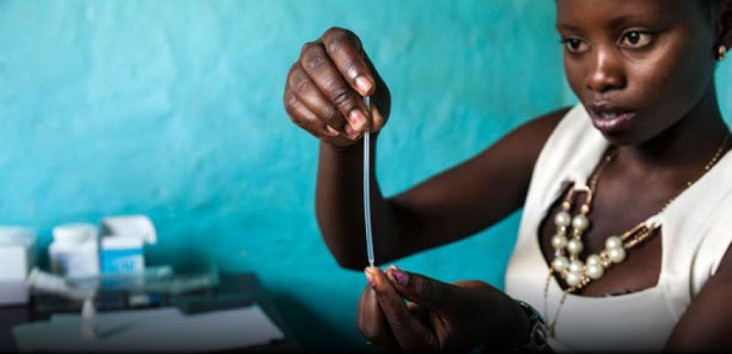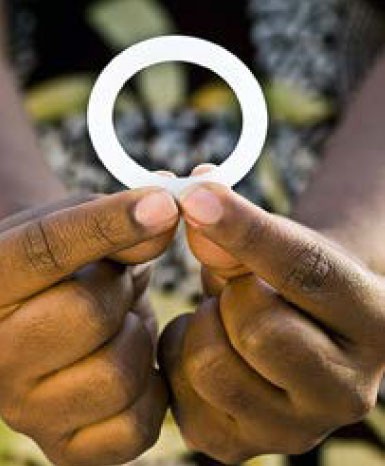- What We Do
- Agriculture and Food Security
- Democracy, Human Rights and Governance
- Economic Growth and Trade
- Education
- Ending Extreme Poverty
- Environment and Global Climate Change
- Gender Equality and Women's Empowerment
- Global Health
- Water and Sanitation
- Working in Crises and Conflict
- U.S. Global Development Lab

With the U.S. Agency for International Development's (USAID's) programmatic assistance, today there are 20 percent fewer HIV infections than 10 years ago, and more than 15 million people are on antiretroviral therapy. Still, an estimated 2 million people are newly infected with HIV every year. In sub-Saharan Africa, 1 in 20 adults is living with HIV, and in the Middle East and North Africa, new infections have increased by more than 35 percent in the last decade. USAID's research agenda maximizes the reach of technically sound, cost-effective, and sustainable HIV and AIDS interventions. Given that women and girls account for more than half of the 34 million people living with HIV worldwide, a particular focus of USAID's research efforts is developing and introducing new women-initiated prevention tools that can provide a range of options to combat HIV.
Health Research Goals
1. Develop, test, and introduce microbicides for women to reduce the risk of HIV infection
2. Accelerate development and clinical testing of novel HIV vaccine candidates and build global capacity for vaccine research
3. Strengthen the programmatic evidence base for HIV and AIDS prevention, care, and treatment to achieve epidemic control
Research Sites
- Cote d'Ivoire
- Dominican Republic
- Ethiopia
- Ghana
- Haiti
- India
- Italy
- Kenya
- Lesotho
- Malawi
- Mozambique
- Namibia
- Netherlands
- Rwanda
- Senegal
- South Africa
- Swaziland
- Sweden
- Tanzania
- Uganda
- United Kingdom
- United States
- Zambia
- Zimbabwe
Goal 1: Develop, test, and introduce microbicides for women to reduce the risk of HIV infection
In early 2016, two trials of the dapivirine vaginal ring for HIV prevention announced their results.This was a landmark moment in the field of microbicides research, as these studies were the first to test the efficacy of a non-gel microbicide delivery system. One trial, ASPIRE, was funded by the National Institutes of Health (NIH), while the other study, the Ring Study, was funded by USAID and other donors. Results from the 2 studies were consistent with one another, with each reporting modest protection of about 30 percent. However, among women 21 and younger, there was no significant protection, while in women older than 21, the protection was substantial, with point estimates of 37 percent and 56 percent in the 2 studies. Adherence was higher in older women, which could explain the differences observed by age. The USAID-supported Ring Study is continuing, now with all participants receiving the active product, and more extended follow-on studies are being planned. Adherence in such trials may be higher when women know they are receiving an effective product. Overall, the results suggest the ring has strong potential as one tool for women to combat HIV.
Other enhanced formulations, dosing regimens, and delivery systems are also being developed and tested to address previously observed adherence challenges for product users.A new more-potent form of oral Pre-Exposure Prophylaxis (PrEP), tenofovir alafenamide fumarate (TAF), is in development and could prove to have fewer side-effects and be more acceptable to users than the currently available forms of PrEP. In addition, given the very low dosage required,TAF-containing oral PrEP is expected to cost much less to manufacture. USAID is also supporting development of products with new mechanisms of actions and longer-acting formulations, including integrase inhibitors, entry blockers, and a biodegradable implant.

Anticipating interest in PrEP and new microbicide formulations once they receive regulatory approval, USAID and partners are now working to prepare relevant countries for the introduction and access programs that will be needed to deliver these products to the women who need them most.These programs will address service delivery, gender issues, product and package design, and resistance concerns. Donor coordination will ensure effective use of resources.
Goal 2: Accelerate development and clinical testing of novel HIV vaccine candidates and build global capacity for vaccine research
With support from USAID, the International AIDS Vaccine Initiative's (IAVI's) Research & Development has deepened their engagement and partnerships with global collaborators, establishing centers of scientific excellence, transferring HIV vaccine science capabilities to Africa and India, and informing national policymakers on the importance of HIV research. In addition to conducting Phase I trials of novel vaccines candidates with African partner institutions to provide data on whether these candidates are suitable for use in African settings, the trials enhance local immunology capabilities and regulatory capacity.These scientific efforts, coupled with in-country policy and advocacy work to train future African leaders in the field of HIV vaccine research and development, contribute to increased country ownership and direct domestic investments.
USAID continues to support the exploration of genetic, viral, and immunological correlates associated with the development of powerful broadly neutralizing antibodies (bNAbs) capable of blocking the virus. Efforts continue to further characterize antibodies isolated from Protocol C, the largest longitudinal study of HIV infection among Africans, and Protocol G, the study that enabled the landmark discoveries of new bNAbs. IAVI expanded its immunogen design work through collaborative research between the HIV Vaccine Translational Research Laboratory in India, the Human Immunology Lab in London, and African Clinical Research Centers already engaged in Protocol C to study the immunology of the neutralizing antibody response. USAID also supports the YR Gaitonde Center for AIDS Research and Education, Chennai, India, to expand Protocol G.This work will lead to an improved understanding of envelope immunogens, which are thought to be needed for an HIV vaccine, particularly during acute infection in Africa study volunteers, while developing pathways for South-South collaboration between Africa and India on immunogen based research.
Goal 3: Strengthen the programmatic evidence base for HIV and AIDS prevention, care, and treatment to achieve epidemic control
USAID's HIV Implementation Science portfolio supports the U.S. President's Emergency Plan for AIDS Relief (PEPFAR), which seeks to achieve sustainable epidemic control and to reach the Joint United Nations Programme on HIV/AIDS' 90-90-90 global goals: 90 percent of people with HIV diagnosed, 90 percent of those on antiretroviral therapy, and 90 percent of them virally suppressed by 2020. In order to achieve these outcomes, PEPFAR embraces an "implementation science" framework to improve the uptake, translation, and implementation of research into service delivery practices. USAID's agenda emphasizes methodological rigor, programmatic context, and sound scientific principles in support of prevention, care, and treatment research.
Our current portfolio provides stakeholders with the data and evidence needed to improve services and inform policy and ultimately achieve 90-90-90. Current activities include:
- Implementation Science APS Awards: 10 studies in 10 countries designed to answer critical questions across the HIV prevention, care, and treatment continuum and to strengthen the integration of HIV services with other health programs.
- An operations research project that includes more than 20 studies and focused evaluations in 14 countries to improve the efficiency, effectiveness, scale, and quality of HIV and AIDS treatment, care, and support, and prevention of mother-to-child transmission of HIV programs.
- A gender-based violence project that identifies and addresses gaps in gender-based violence prevention and service delivery through intensive monitoring and evaluation of gender based violence programs.
- A project that researches and evaluates innovations and HIV program implementation and measures the feasibility, impact, and effectiveness of different approaches, strengthens capacity among local research institutions, and promotes data dissemination and utilization of study findings by policymakers and stakeholders. In its first year, this project initiated 15 studies in 14 countries.
Download a PDF of this page [PDF, 127KB]
Read the expanded Global Health HIV and AIDS research section [PDF, 277KB}.







Comment
Make a general inquiry or suggest an improvement.